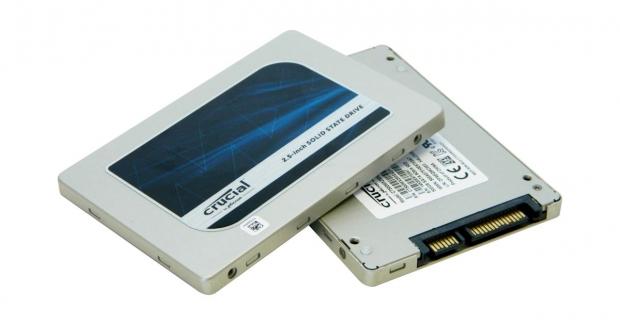Introduction, Drive Specifications, Pricing and Availability
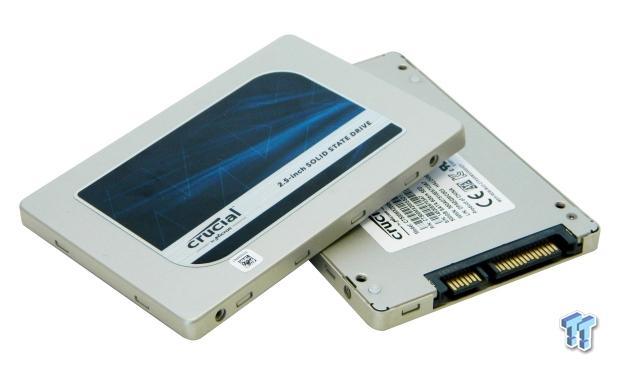
Crucial is back at it again. Taking and building upon the huge success that is the MX100. The drive we are looking at today is the newly launched MX200 500GB SATA III SSD. The MX200 retains the same high quality components as the MX100 as well as the MX100's incredibly low price point. The MX200 is outfitted with high quality MLC NAND in BGA packages, host power-loss protection, a Marvell 88SS9189-BLD2 8-channel flash processor, and a new feature called Dynamic Write Acceleration. Dynamic Write Acceleration, or DWA, is where the MX200 differs most from the MX100, however this feature is available only in the 250GB capacity where it is most beneficial. 500GB and 1TB capacity drives don't need DWA, as their performance is amazing on its own.
Most of the performance uptick the 250GB MX200 provides over the previous generation MX100 256GB is facilitated by Crucial's proprietary Dynamic Write Acceleration technology. DWA differs from typical SLC emulation in that like the name suggests it is dynamic in nature as opposed to competing fixed pool emulated SLC technology. Crucial employs Adaptive Thermal Protection technology that dynamically adjusts component activity keeping temperatures within a specific safe range. Adaptive Thermal Protection is a nice feature, but something that is unlikely to kick-in, because it's nearly impossible to get 16nm flash hot.
On the data protection front, Crucial arms the MX200 with RAIN redundancy technology, increasing protection of your data in a similar fashion as RAID on multiple drives. In addition, Crucial is utilizing a 4-layer Data Defense scheme to virtually insure every bit of data is 100% safe.
Keeping data safe from potential hackers is another high priority for Crucial. To combat data theft of your personal files and sensitive corporate information, Crucial outfits the MX200 with high-level encryption features that users may employ for the ultimate in data security. The MX200 keeps data safe with banking grade AES 256 bit encryption that meets or exceeds all industry encryption standards including TCG Opal 2.0, Microsoft eDrive and IEEE-1667.
Until recently, Crucial has been lacking a little on the drive management front. Well, that's history with the introduction of Micron's Storage Executive SSD toolbox. Micron's Storage Executive toolbox is a surprisingly polished piece of software that allows you to easily manage your Crucial SSD and perform all necessary maintenance functions quickly and easily. We will be taking an in-depth look at the features and functions of Storage Executive in this review.
Crucial has covered all the bases that make up a well-rounded drive, and introduced some exclusive features that should yield improved performance, all without increasing cost over the MX100. Let's dive-in and see what we can extract from Crucial's newest SSD.
Specifications
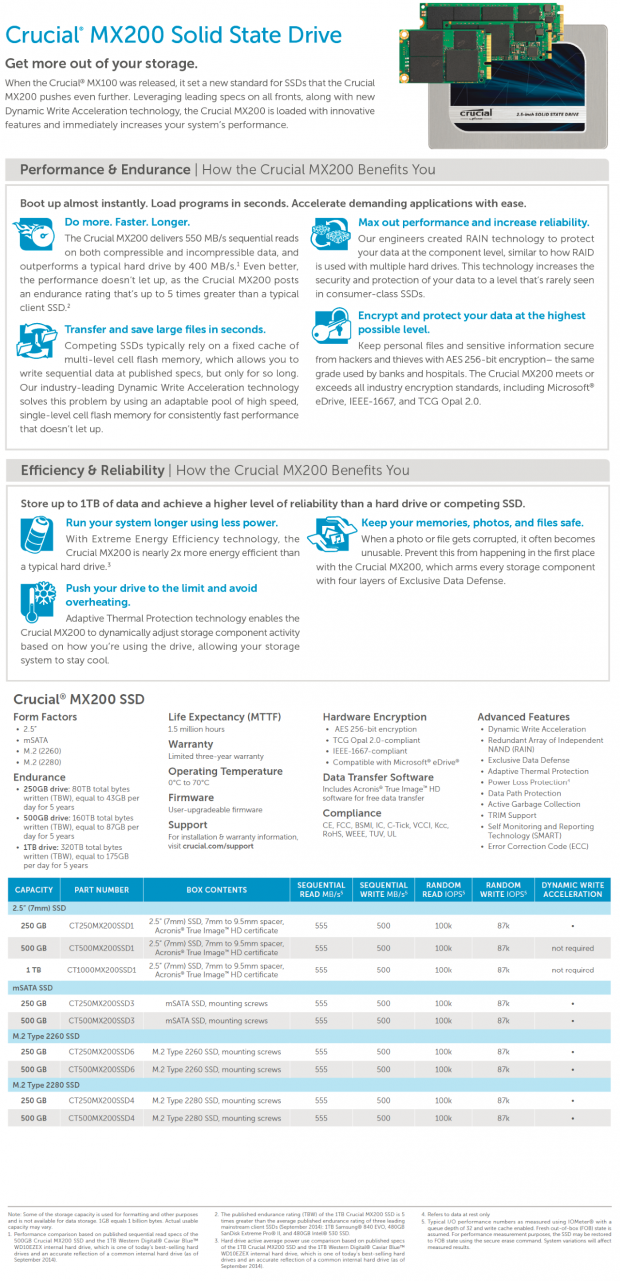
Crucial's MX200 SATA III SSD is available in 3 capacity sizes, 250GB, 500GB and 1TB. Sequential performance of the MX200 is listed at 555/500 read/write. Random read/write performance is listed at up to 100,000/87,000 IOPS at all capacity points. Of particular interest is the high endurance guarantee that the MX200 carries. The 250GB capacity MX200 comes with a TBW guarantee of 80TB, the 500GB capacity a TBW guarantee of 160TB and the 1TB model a guaranteed TBW of 320TB.
This is class leading endurance and something virtually unseen from consumer based SSD's to this point. Crucial's MX200 SATA III SSD comes in a 2.5" x 7mm Z-height form factor and ships with a spacer should you need to increase the drives thickness to 9.5mm. Crucial includes an Acronis key as a value add. Crucial backs the MX200 with an industry standard 3-year warranty or TBW allowed during the 3 year warranty period, whichever comes first.
PRICING: You can find Crucial's MX200 (500GB) for sale below. The prices listed are valid at the time of writing but can change at any time. Click the link to see the very latest pricing for the best deal.
United States: The Crucials MX200 500GB retails for $209.99 USD at Amazon USA.
Canada: The Crucials MX200 500GB retails for $274.99 CDN at Amazon Canada.
Drive Details, Test System Setup, Array Properties
Drive Details - Crucial MX200 500GB SSD
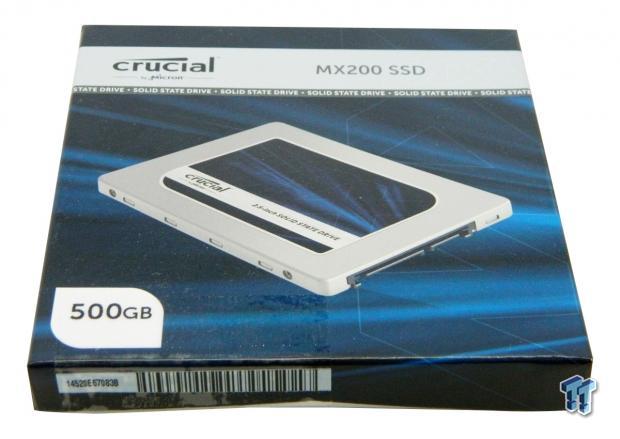
Crucial packages their MX200 SATA III SSD in an attractive blue and silver flip-top box. There is a picture of the drive on the top of the box.
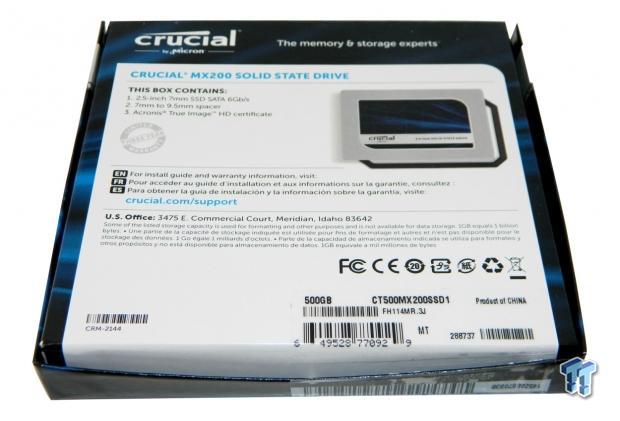
The rear of the box lists the contents, as well as another picture of the drive and the included spacer.
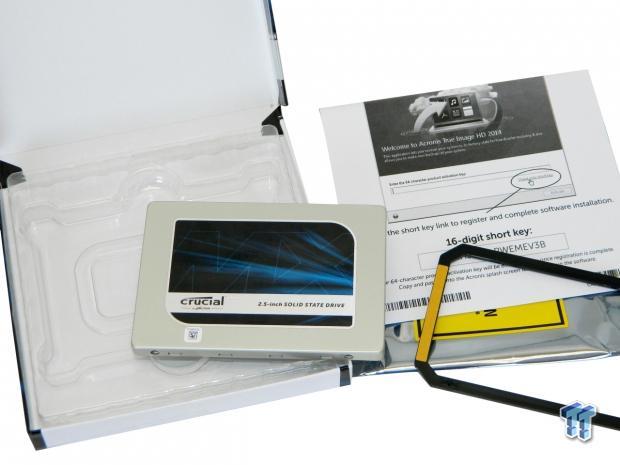
Here is the complete contents of the drives packaging.
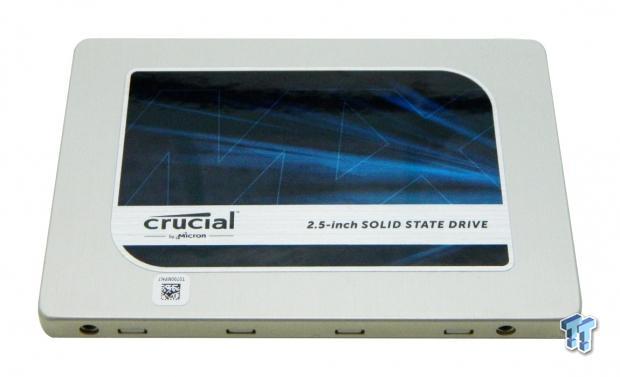
Crucial moved away from their typical reverse labeling with the MX200. The top and sides of the drives enclosure are formed from a single piece of sheet aluminum that interlocks with the bottom half of the enclosure. The enclosure is natural aluminum in color. There is an attractive blue and silver sticker on the face of the top half of the enclosure.

The bottom and inner sides of the drives enclosure are formed from another single piece of interlocking sheet aluminum. A manufacturer's sticker lists the drives capacity, shipping firmware, model number, serial number and various other relevant information.
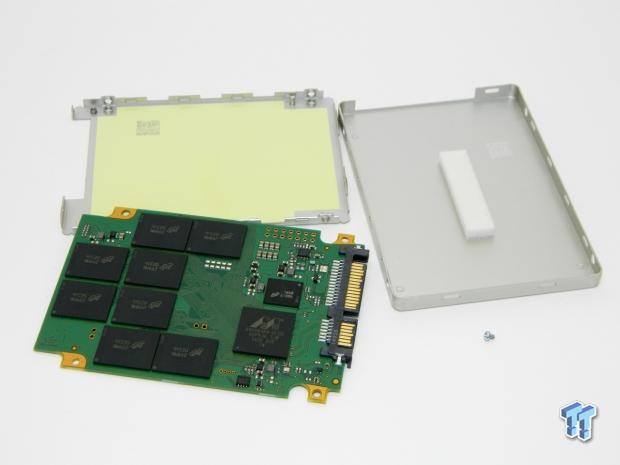
Here's what Crucial's MX200 500GB SSD looks like completely disassembled. There are a total of (8) 64GB 16nm BGA NAND packages, 1 DDR package and a Marvell 88SS9189-BLD2 flash processor. Host power loss protection is provided via a total of 16 capacitors, 8 are located on this side of the PCB and another 8 on the opposite side of the PCB. The PCB is secured to the enclosure by a single screw and 2 locator pins. All chips on the board make contact with a Mylar type thermal sheet that is affixed to the top half of the enclosure. There is a thick, white, non-thermal foam strip that acts as a spacer affixed to the bottom of the drives enclosure ensuring that the PCB stays secured within the locating pins.
Test System Setup
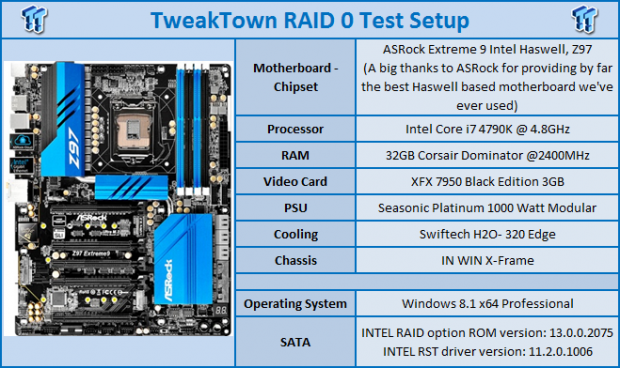
- Array Properties
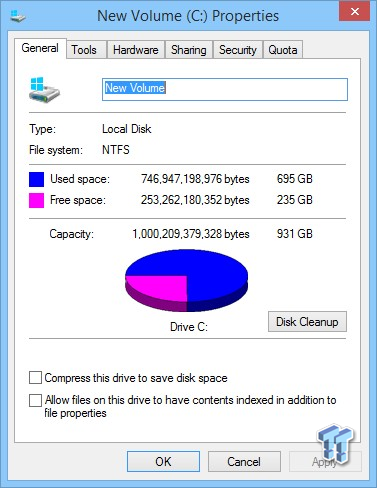
The majority of our testing is performed with our test drive/array as our boot volume. Our boot volume is 75% full for all OS Disk "C" drive testing to replicate a typical consumer OS volume implementation. We are using 64k stripes for our all our 3-drive arrays. Cstates and Speed stepping are both disabled in our systems BIOS, High Performance power plan is enabled in Windows, Write-back caching is enabled via Intel's RST control panel, and Windows buffer flushing is disabled. We will be charting the performance of our featured array as well as a single drive. We are utilizing Windows 8.1 64-bit for all of our testing.
SSD Toolbox
Micron Storage Executive SSD Toolbox
A month or so ago, Micron introduced a nice piece of software for SSD management. This toolbox works with all Crucial SSD's from the M500 forward. Storage executive has all the necessary management features that compliment SSD ownership. With Storage Executive, you can monitor your drives health, view how much data has been written to the drive, perform a secure erase and update firmware easily.
If you would like to download this toolbox you can do so by clicking here.
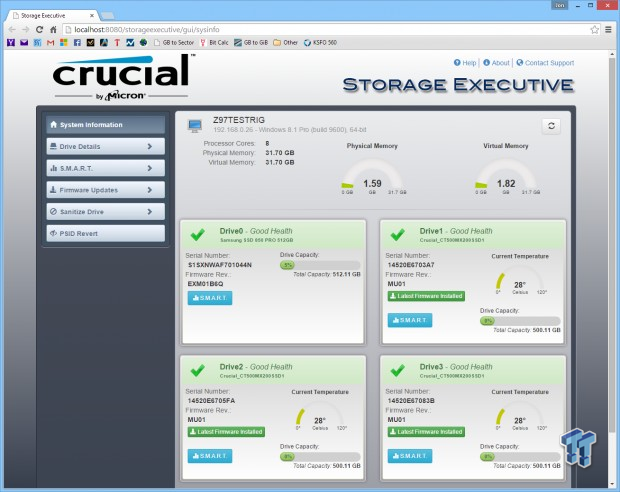
Storage Executive opens in your internet browser.
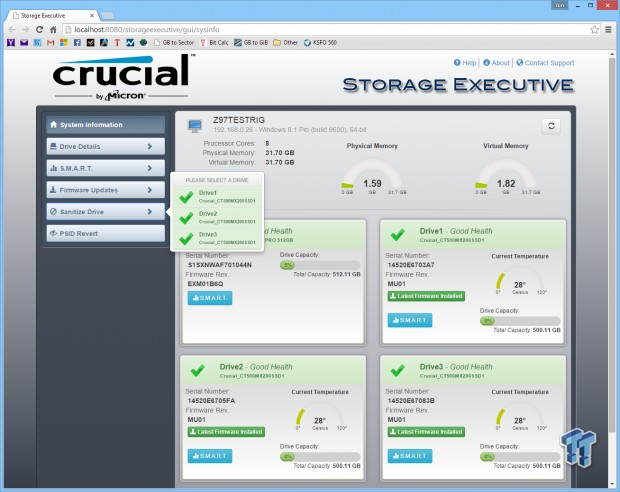
The System Information tab gives you a brief system overview, lists your attached SATA drives, their health status, capacity, serial number, firmware status and installed firmware. The System Information page tells you the current temperature of your Crucial/Micron drives.

Clicking on a drive gives you more detailed information, including the amount of data that has been written to the drive over its lifetime
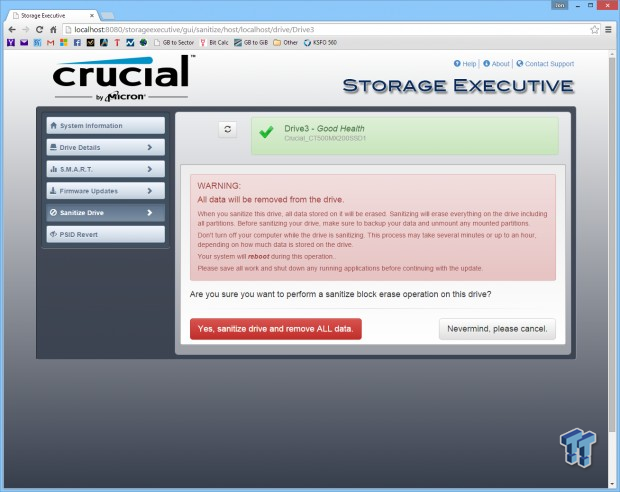
If we hit the Sanitize Drive tab, we can select the Crucial/Micron drive we want to secure erase. Note: You can only SE in AHCI mode, RAID mode does not work, and is our lone complaint about Storage executive.
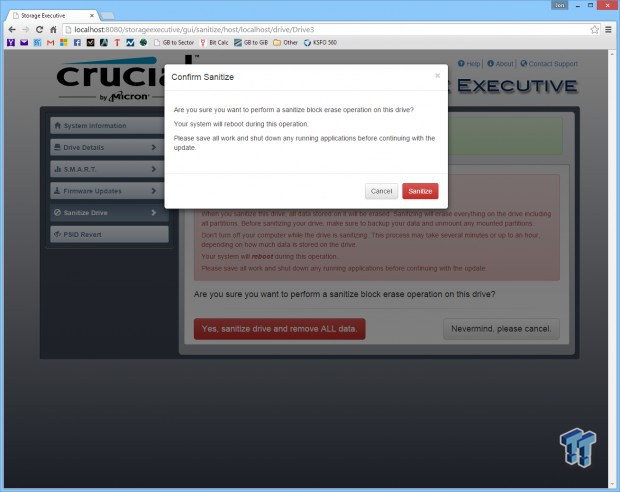
Before Storage Executive will reboot your computer and secure erase it, you have to grant permission.
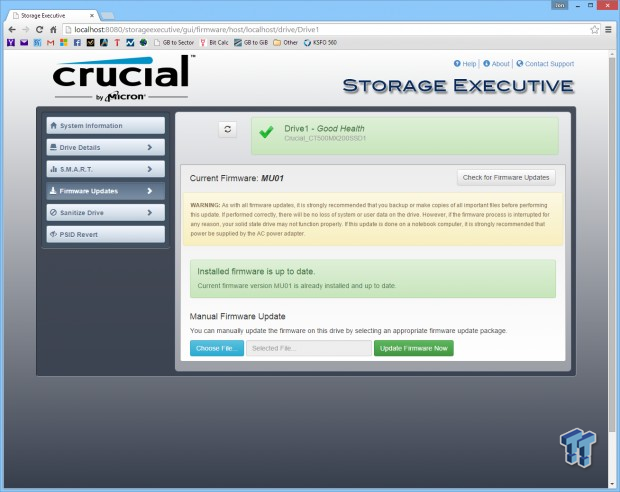
The Firmware Update tap allows you to update your drives firmware. Ours is up to date.
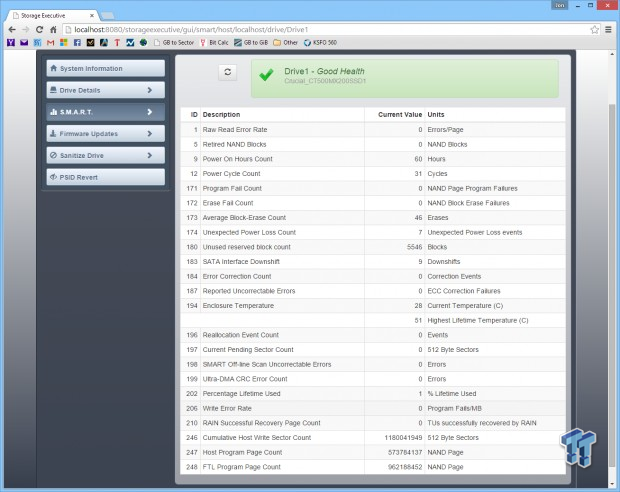
The S.M.A.R.T. tab lists all monitored attributes of your Crucial/Micron drive.
Overall, Micron's Storage Executive is a very nice piece of management software. The only complaint we have is that you have to be in AHCI mode for the Sanitize Drive function to work. It would be nice if it would work in RAID mode as well.
Synthetic Benchmarks - ATTO, Anvil Storage Utilities, CrystalDiskMark & AS SSD
ATTO
Version and / or Patch Used: 2.47
ATTO is a timeless benchmark used to provide manufacturers with data used for marketing storage products.
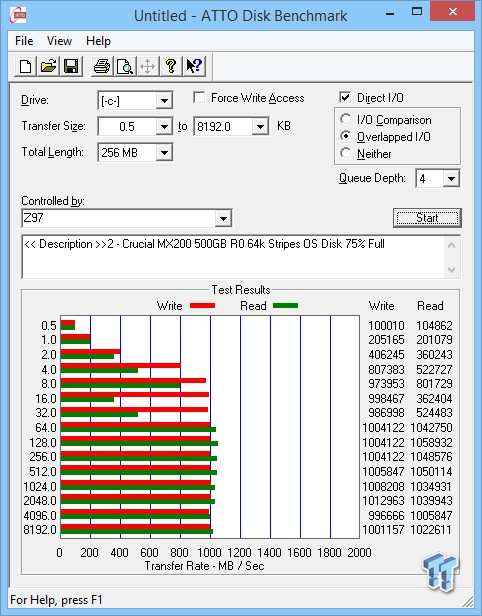
Sequential read transfers max out at 1.001 GB/s. Sequential write transfers max out at 0.959 GB/s.
Sequential Write
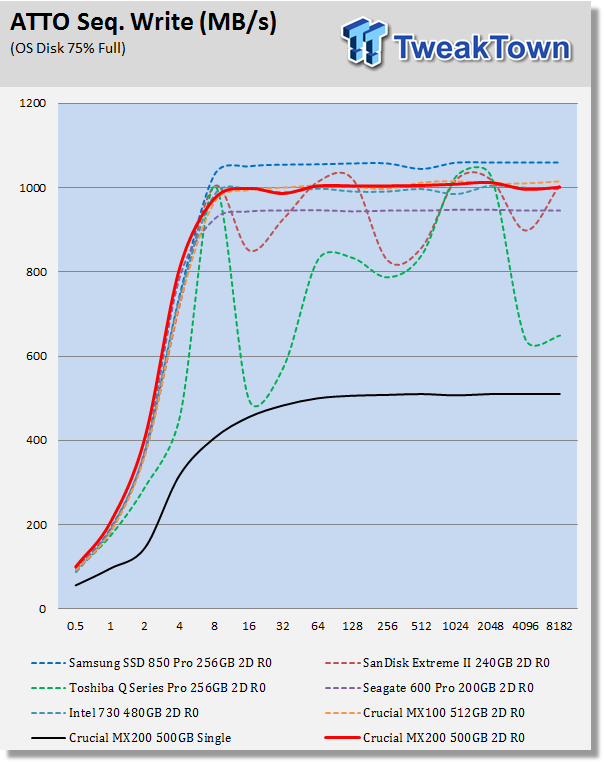
Our MX200 arrays sequential write performance ramps up faster than the rest of the arrays on our chart. Our 850 Pro array though, is the clear winner of this test.
Sequential Read
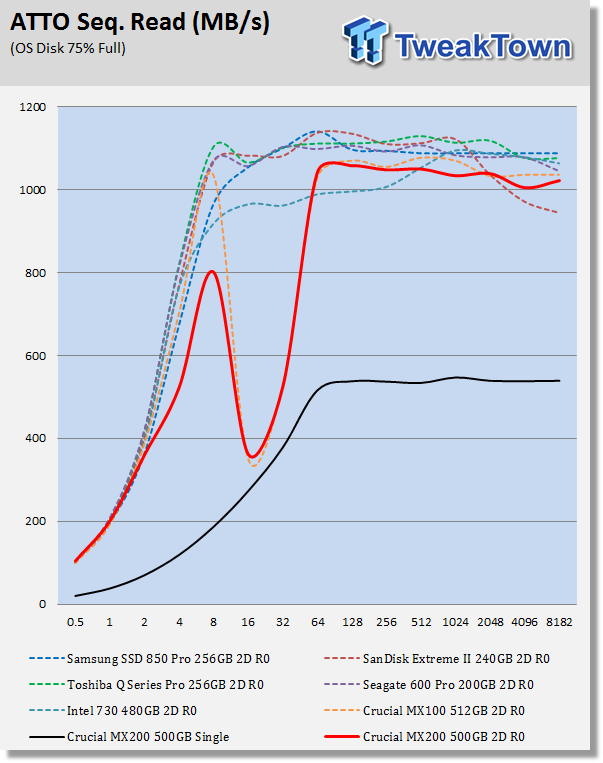
Sequential read performance of our MX200 array is near the bottom of the charts in this test; however, this means very little as you will see.
Anvil Storage Utilities
Version and / or Patch Used: RC6
Anvil's Storage Utilities is a storage benchmark designed to measure the storage performance of SSD's. The Standard Storage Benchmark performs a series of tests; you can run a full test or just the read or write test, or you can run a single test, i.e. 4k QD16.
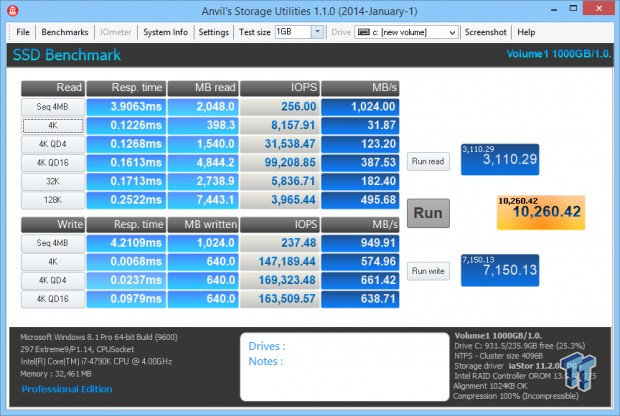
Any time a two-drive array can hit 10,000 points with Windows 8.1, this indicates a very powerful array. This is the second best performance by any array we've tested to date.
Read IOPS through Queue Depth Scale
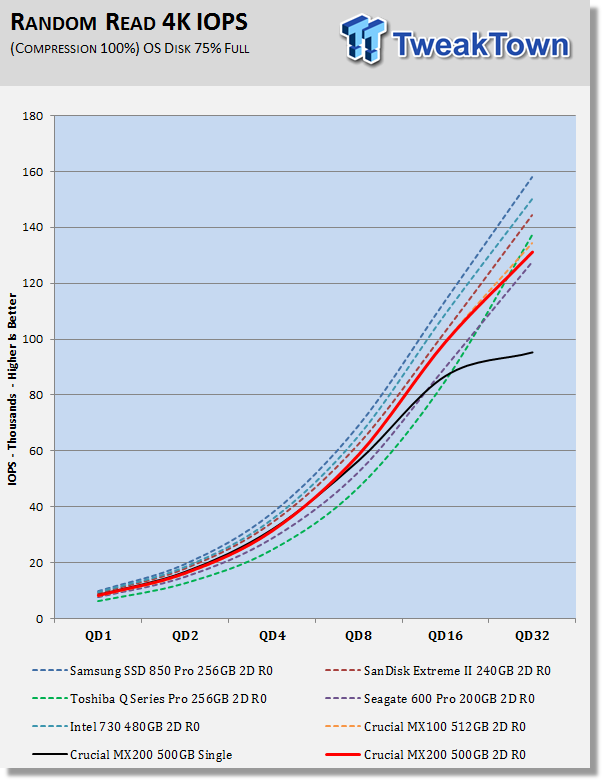
Random read performance is not where 16nm IMFT NAND shines. Our MX200 array finishes in the bottom half of the arrays on our chart.
Write IOPS through Queue Scale
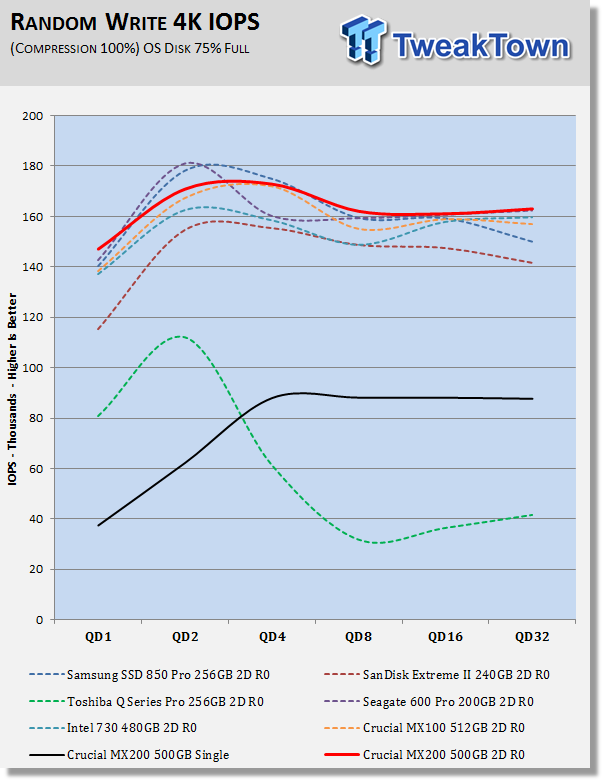
Our MX200 array starts and finishes ahead of the rest of the arrays on our chart. Most importantly random write performance at QD1 is superior to any array we've tested to date.
CrystalDiskMark
Version and / or Patch Used: 3.0 Technical Preview
CrystalDiskMark is disk benchmark software that allows us to benchmark 4k and 4k queue depths with accuracy.
Note: Crystal Disk Mark 3.0 Technical Preview was used for these tests since it offers the ability to measure native command queuing at QD4.
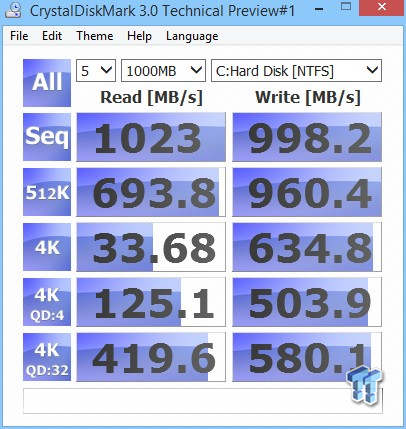
Our MX200 Array has the best 4K QD1 write performance of any array running on Windows 8.1 to come through the lab to date. This is what we consider the most important performance metric, so there is no doubt that the MX200 is a beast.
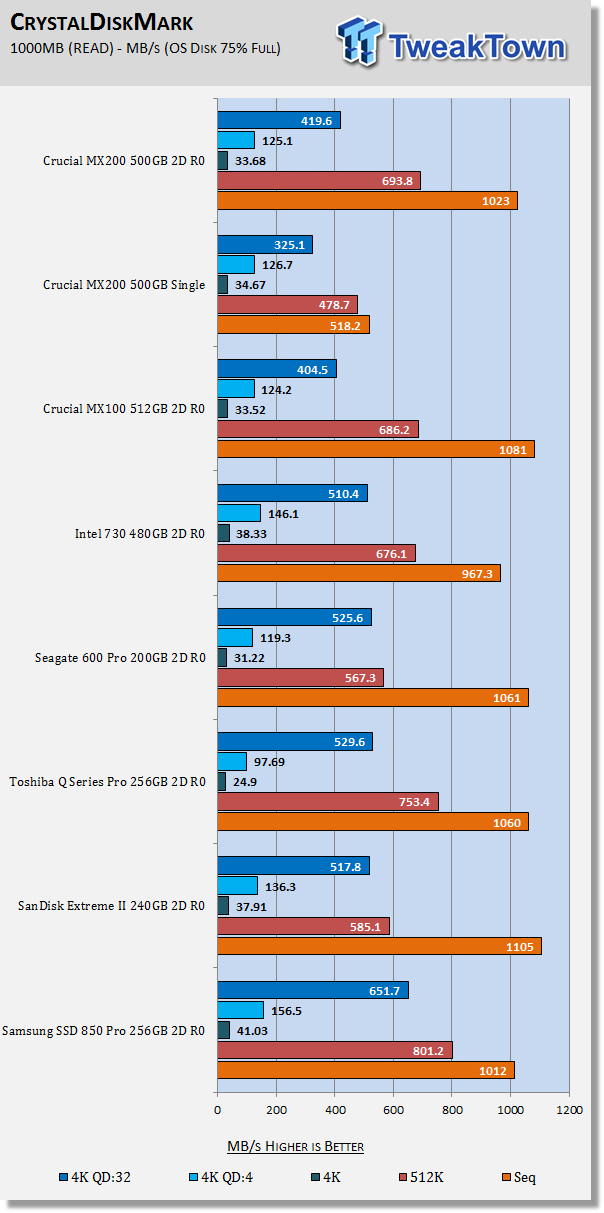
Breaking down read performance reveals our MX200 array outperforming our MX100 array in all categories except for sequential. The one weak point, if you could call it that, is 4K QD32. 4K QD32 is the least important category next to sequential performance, so we're not worried about that in the least. Sequential performance although not the fastest is still great, faster than our 850 Pro array.
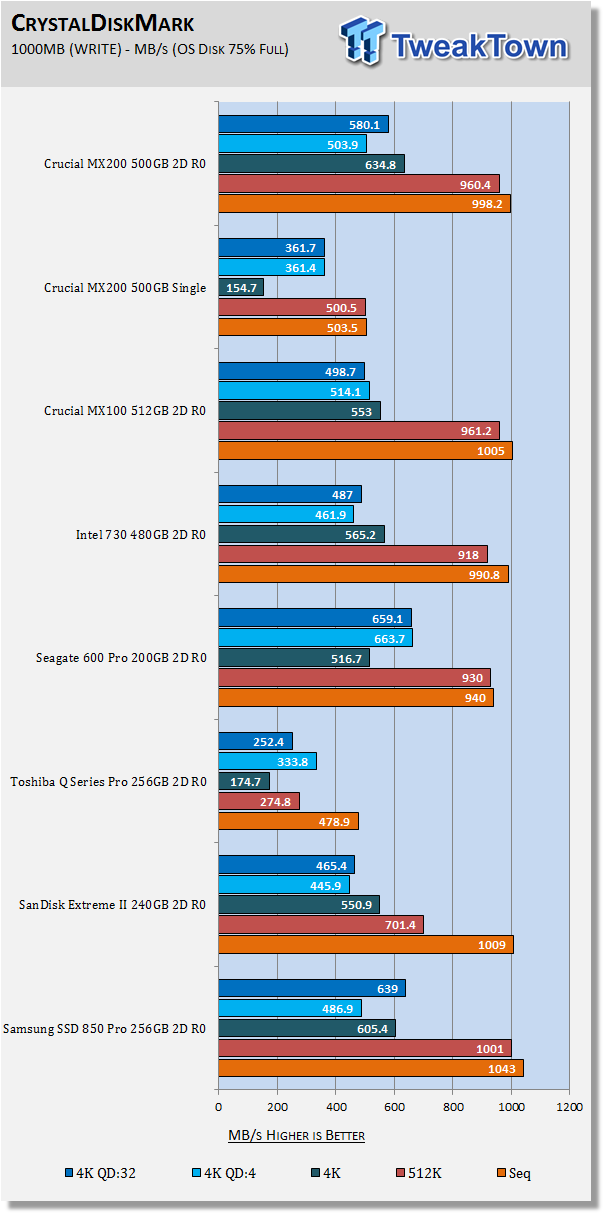
Write performance is where our MX200 array shines. It's more important than read. Overall our MX200 is able to outperform our MX100 array. In the category we consider most important, 4K QD1, our MX200 array leaves the other arrays on our chart in the dust. This is a good indicator that write transfer rates will be outstanding.
AS SSD
Version and / or Patch Used: 1.7.4739.38088
AS SSD determines the performance of Solid-State Drives (SSD). The tool contains four synthetic as well as three practice tests. The synthetic tests are to determine the sequential and random read and write performance of the SSD.
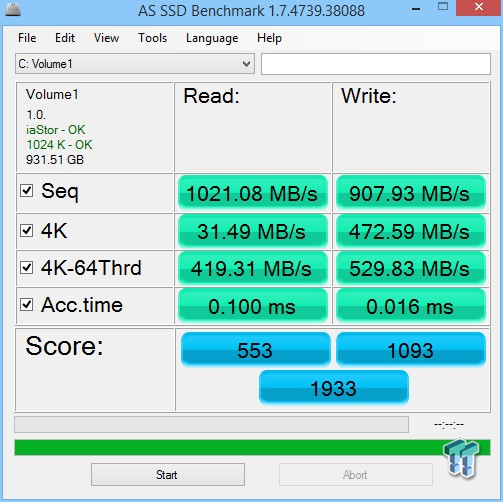
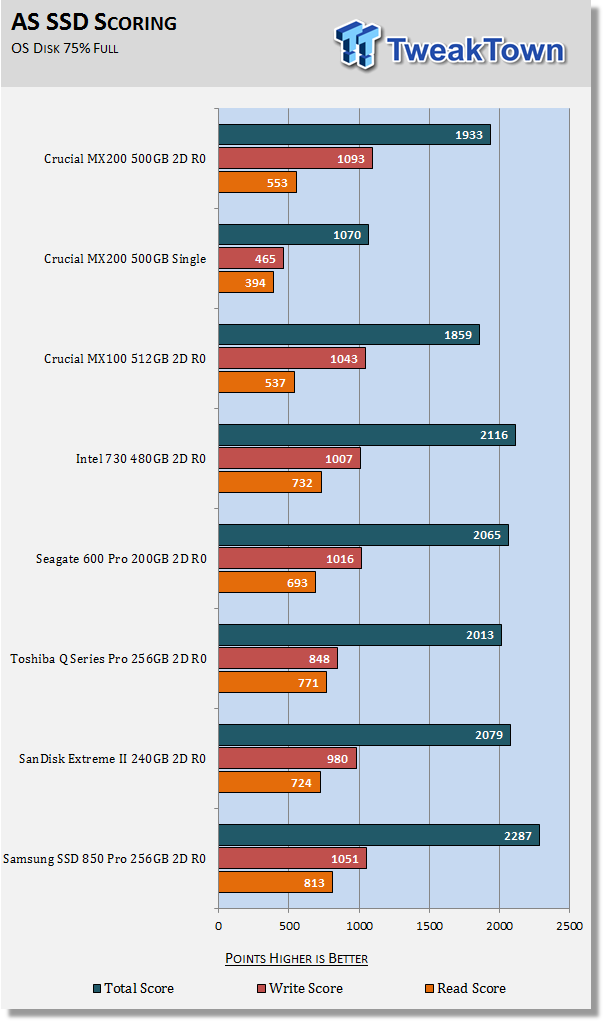
Both our MX100 and MX200 arrays have the lowest score on the chart, but that is because they are the only drives equipped with 16nm NAND. 16nm NAND does not deliver as good of performance with random reads at high QD where so much of the total score is derived. When we take a closer look though, we see what we've seen all along, our MX200 array writes better than any array to come across our bench to date. Again, we see proof that Crucial has been able to crank up performance a notch in comparison to the MX100 it is replacing.
Benchmarks (Trace Based OS Volume) - PCMark Vantage, PCMark 7 & PCMark 8
Light Usage Model
We are going to categorize these tests as indicative of a light workload. If you utilize your computer for light workloads like browsing the web, checking emails, light gaming, and office related tasks, then this category of results is most relevant for your needs.
PCMark Vantage - Hard Disk Tests
Version and / or Patch Used: 1.2.0.0
The reason we like PCMark Vantage is because the recorded traces are played back without system stops. What we see is the raw performance of the drive. This allows us to see a marked difference between scoring that other trace-based benchmarks do not exhibit. An example of a marked difference in scoring on the same drive would be empty vs. filled vs. steady state.
We run Vantage three ways. The first run is with the OS drive/Array 75% full to simulate a lightly used OS volume filled with data to an amount we feel is common for most users. The second run is with the OS volume written into a "Steady State" utilizing SNIA's guidelines (Rev 1.1). Steady state testing simulates a drive/array's performance similar to that of a drive/array that has been subjected to consumer workloads for extensive amounts of time. The third run is a Vantage HDD test with the test drive/array attached as an empty, lightly used secondary device.
OS Volume 75% Full - Lightly Used
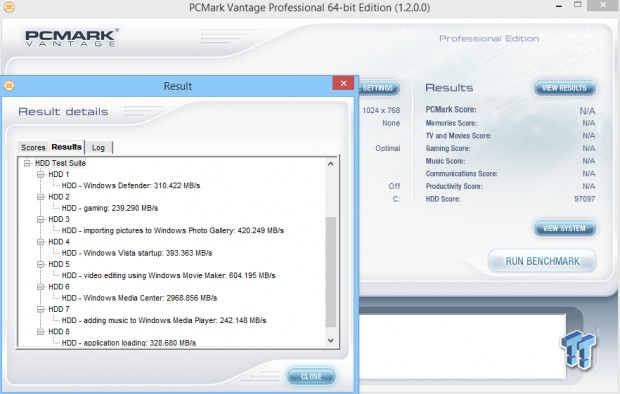
OS Volume 75% Full - Steady State
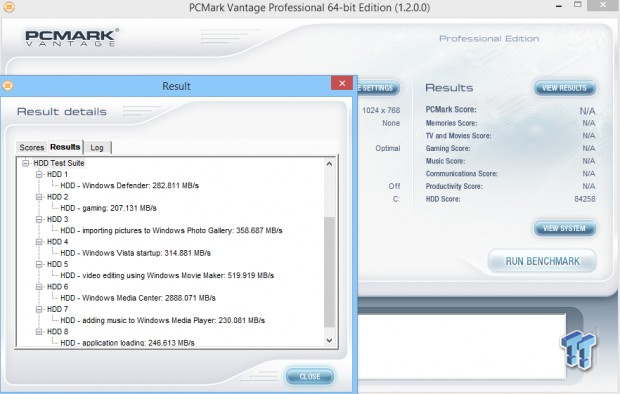
Secondary Volume Empty - Lightly Used
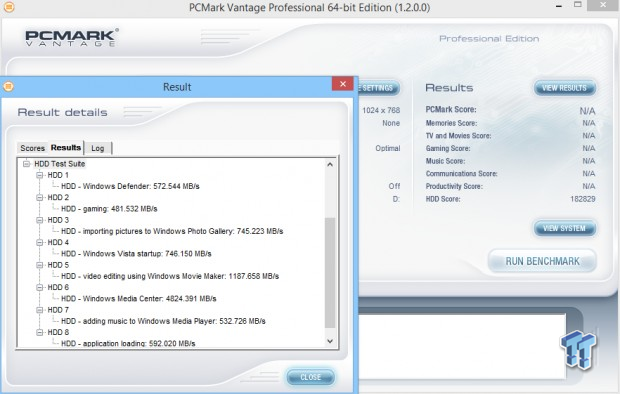
As you can see, there's a big difference between an empty drive/array, one that's 75% full/used, and one that's in a steady state.
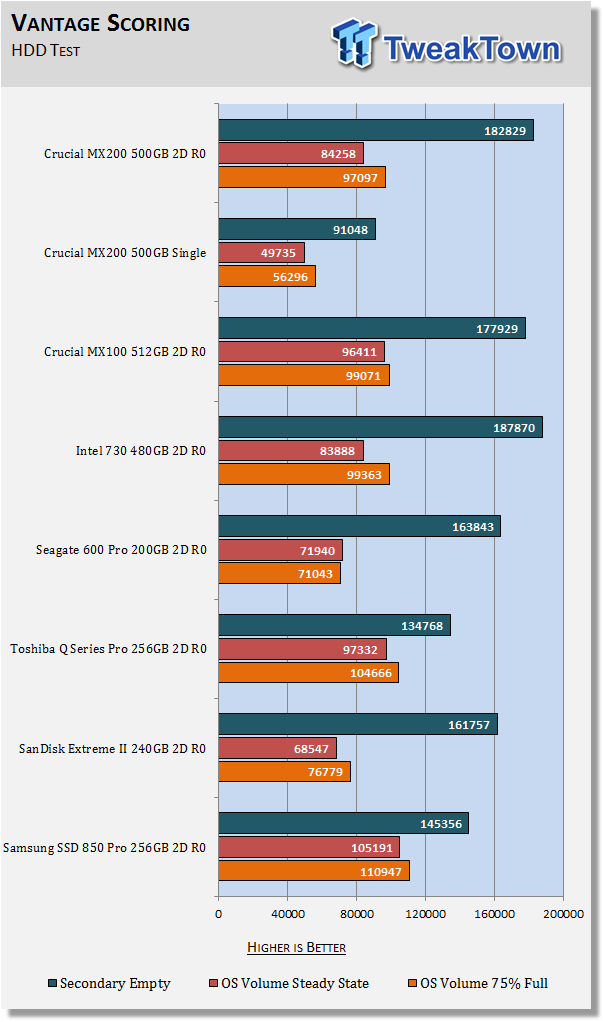
The important scores to pay attention to are "OS Volume Steady State" and "OS Volume 75% full." These two categories are most important because they are indicative of typical of consumer user states.
When a drive/array is in a steady state, it means garbage collection is running at the same time it's reading/writing. This is exactly why we focus on steady state performance.
This time our MX200 array takes a backseat to our MX100 array. Our Mx200 array puts up the second best empty performance we've seen to date, surpassing our MX100 array in this category. Steady state performance is a little lower than we expected to see, but still very robust. Our MX200 array is able to defeat our current RAID champion, Intel's 730, in the steady state category, but our 850 Pro array runs away with this test.
PCMark 7 - System Storage
Version and / or Patch Used: 1.4.00
We will look to the Raw System Storage scoring for RAID 0 evaluations because it's done without system stops and therefore allows us to see significant scoring differences between drives/arrays.
OS Volume 75% Full - Lightly Used
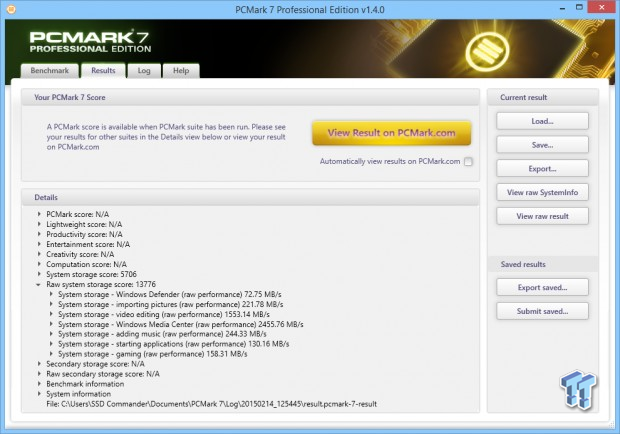
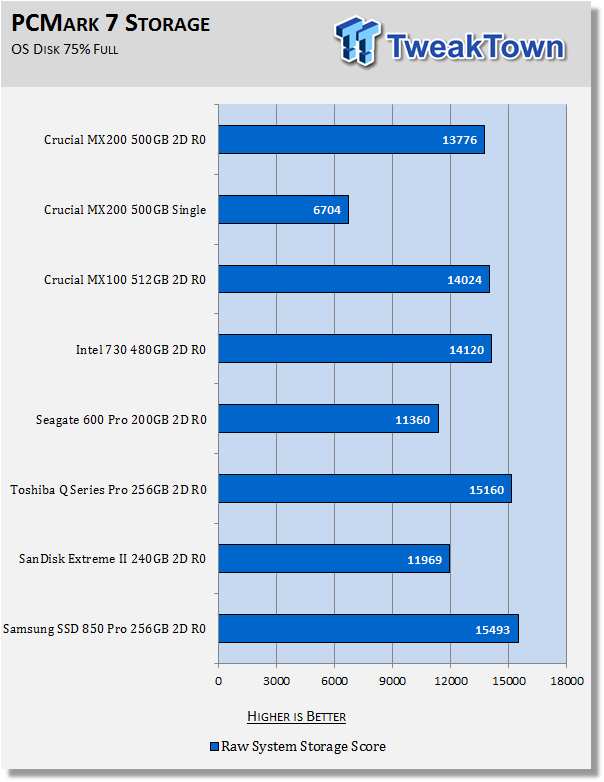
In this round of testing, our MX200 array finishes in the bottom half of the arrays on our chart. Again, our MX100 array is able to put up better numbers. Let's see if this trend continues or if the MX200 has enough improvements under the hood to make a comeback in testing that we place a higher importance on.
PCMark 8 - Storage Bandwidth
Version and / or Patch Used: 1.2.157
We use the PCMark 8 Storage benchmark to test the performance of SSDs, HDDs, and hybrid drives with traces recorded from Adobe Creative Suite, Microsoft Office, and a selection of popular games. You can test the system drive or any other recognized storage device, including local external drives. Unlike synthetic storage tests, the PCMark 8 Storage benchmark highlights real-world performance differences between storage devices.
OS Volume 75% Full - Lightly Used
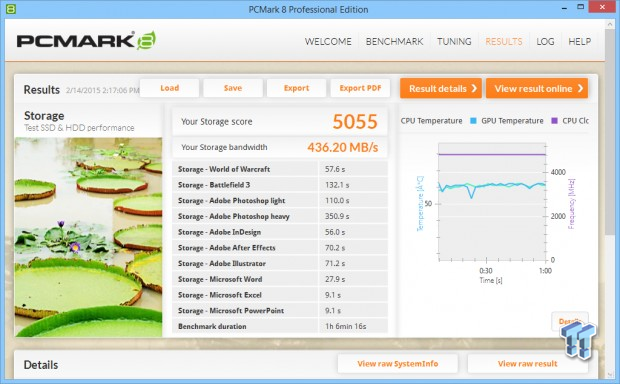
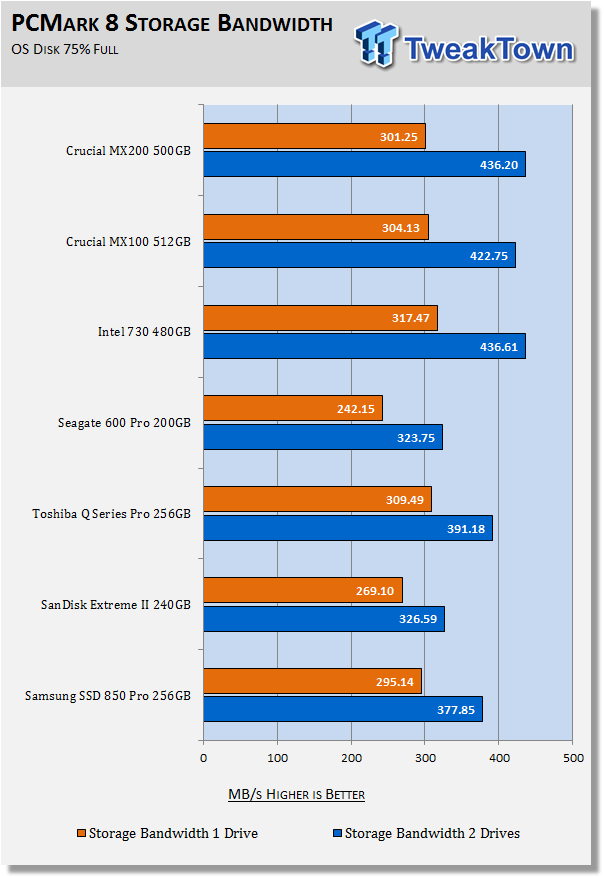
PCMark 8 is the most intensive light model workload simulation we run. Our MX200 array comes back with a vengeance, decimating all but our Intel 730 array. The MX200 scales in an array slightly better than the MX100. The Toshiba flash-based arrays and our Samsung flash-based array aren't even close. This is what we love about IMFT NAND, it typically scales far better than competing flash.
Benchmarks (Secondary Volume) - Disk Response & Transfer Rates
Iometer - Disk Response
Version and / or Patch Used: 1.1.0
We use Iometer to measure disk response times. Disk response times are measured at an industry accepted standard of 4k QD1 for both write and read. Each test is run twice for 30 seconds consecutively, with a 5-second ramp-up before each test. The drive/array is partitioned and attached as a secondary device for this testing.
Write Response
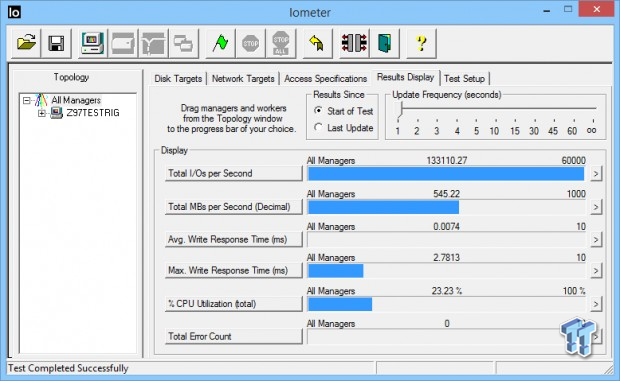
Read Response
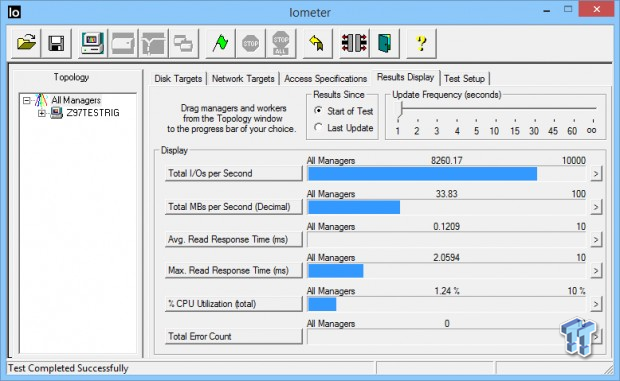
Average Disk Response
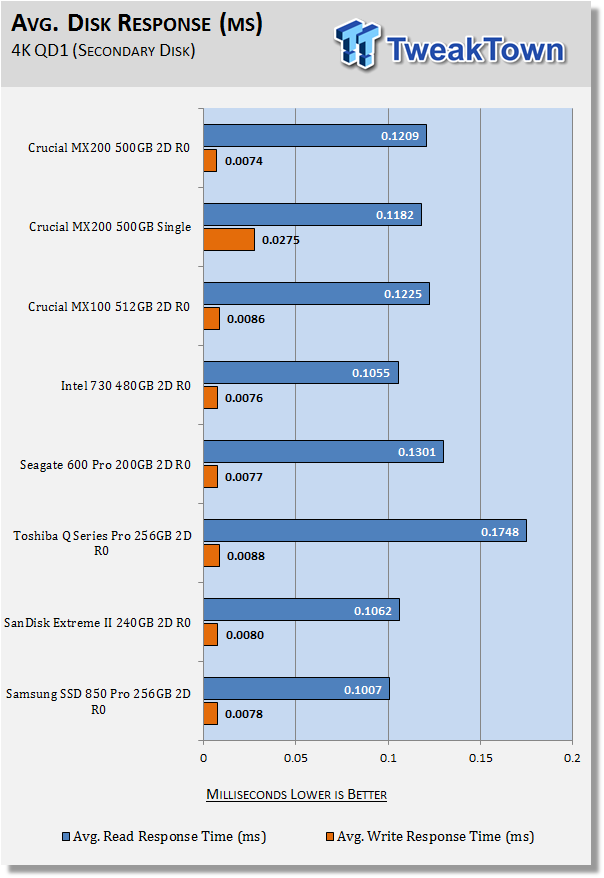
Just as we expected we would see, our MX200 array sets the bar with the lowest write response times of any 2-drive array to come across our test bench. Significantly faster than our MX100 array, which again shows the performance increase Crucial was able to exact from their newest SSD. Read response times are better than the MX100, but nothing like we see from Samsung's 850 Pro. Keep in mind that write performance is more important than read, and in that regard the MX200 is an absolute beast.
DiskBench - Directory Copy
Version and / or Patch Used: 2.6.2.0
We use DiskBench to time a 28.6GB block (9,882 files in 1,247 folders) of mostly incompressible random data as it's transferred from our DC P3700 PCIe NVME SSD to our test drive/array. We then read from a 6GB zip file that's part of our 28.6GB data block to determine the test drive/array's read transfer rate. The system is restarted prior to the read test to clear any cached data, ensuring an accurate test result.
Write Transfer Rate
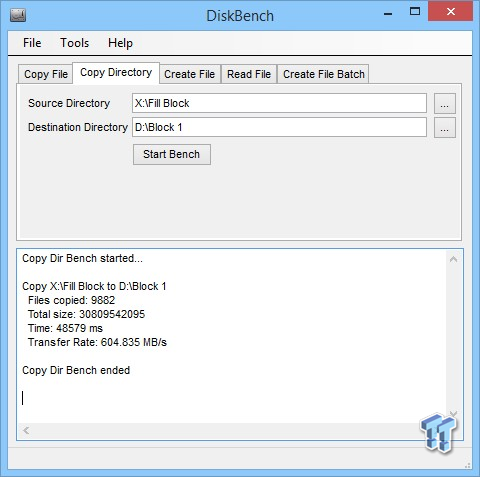
Read Transfer Rate
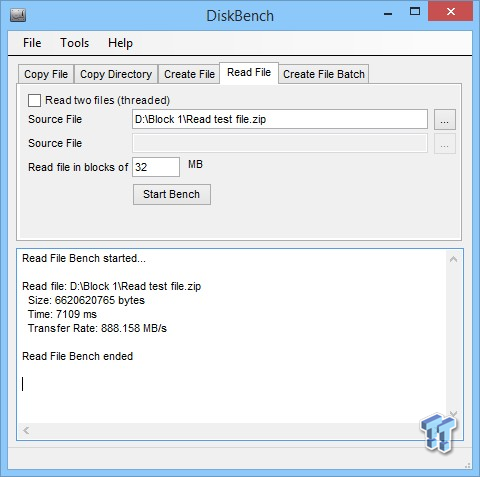

Look at that, not only does our MX200 2 drive array roast the competition with far superior write transfer rates than any 2 drive array we've seen to date, it even manages to outperform our read-centric 850 Pro array with a better read transfer rate. We figured our MX200 array would deliver awesome transfer rates, but we didn't expect they would be this good.
Benchmarks (Secondary Volume) - PCMark 8 Extended
Futuremark PCMark 8 Extended - Consistency Test
Heavy Usage Model
We consider PCMark 8's consistency test to be our heavy usage model test. This is the usage model most enthusiasts, heavy duty gamers, and professionals fall into. If you do a lot of gaming, audio/video processing, rendering, or have workloads of this nature, then this test will be most relevant to you.
PCMark 8 has built-in, command line executed storage testing. The PCMark 8 Consistency test measures the performance consistency and the degradation tendency of a storage system.
The Storage test workloads are repeated. Between each repetition, the storage system is bombarded with a usage that causes degraded drive performance. In the first part of the test, the cycle continues until a steady degraded level of performance has been reached. (Steady State)
In the second part, the recovery of the system is tested by allowing the system to idle and measuring the performance after 5-minute long intervals. (Internal drive maintenance: Garbage Collection (GC))
The test reports the performance level at the start, the degraded steady-state, and the recovered state, as well as the number of iterations required to reach the degraded state and the recovered state.
We feel Futuremark's Consistency Test is the best test ever devised to show the true performance of solid-state storage in a heavy usage scenario. This test takes on average 13 to 17 hours to complete, and it writes somewhere between 450GB and 14,000GB of test data, depending on the number of drives/array being tested. If you want to know what an SSD's performance is going to look like after a few months or years of heavy usage, this test will show you.
Here's a breakdown of Futuremark's Consistency Test:
Precondition phase:
1. Write to the drive sequentially through up to the reported capacity with random data.
2. Write the drive through a second time (to take care of overprovisioning).
Degradation phase:
1. Run writes of random size between 8*512 and 2048*512 bytes on random offsets for 10 minutes.
2. Run performance test (one pass only).
3. Repeat 1 and 2 for 8 times, and on each pass increase the duration of random writes by 5 minutes.
Steady state phase:
1. Run writes of random size between 8*512 and 2048*512 bytes on random offsets for 50 minutes.
2. Run performance test (one pass only).
3. Repeat 1 and 2 for 5 times.
Recovery phase:
1. Idle for 5 minutes.
2. Run performance test (one pass only).
3. Repeat 1 and 2 for 5 times.
Storage Bandwidth
PCMark 8's Consistency test provides a ton of data output that we can use to judge a drive/arrays performance.
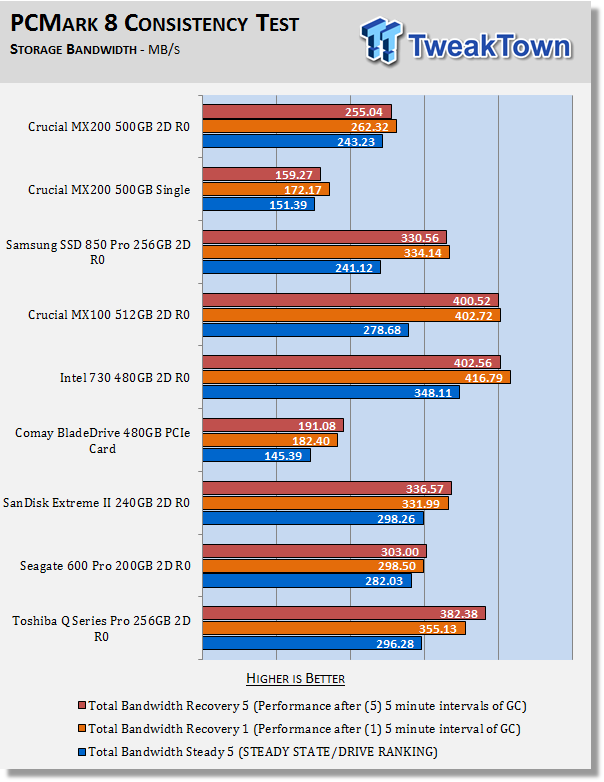
We consider steady state bandwidth (the blue bar) our test that carries the most weight in ranking a drive/arrays performance. The reason we consider steady state performance more important than performance after internal drive maintenance: Garbage Collection (GC) is that when you are running a heavy-duty workload, GC typically will not be occurring while a workload is being executed unless your SSD is already in a steady state. GC performance (the orange and red bars) is what we consider the second most important consideration when ranking a drive/arrays performance. Trace based consistency testing is where true high performing SSDs are separated from the rest of the pack.
Not what we were expecting. Our MX200 array does manage to defeat our 850 Pro array, and of course the highly touted (by some) Comay BladeDrive PCIe card, but that's it. This time we will give the MX200 a pass, which is something we've never done before, but that is ONLY because we know what happens when we add a third drive into the mix. Because we know a third drive makes such a huge difference we are left wondering if this was somehow a bad run? Well, it is what it is, and we aren't going to run another 14 hour test to make sure.
One thing we can take away from this test is that the MX200 is relatively unaffected by garbage collection, which is quite the opposite of what we see with the MX100.
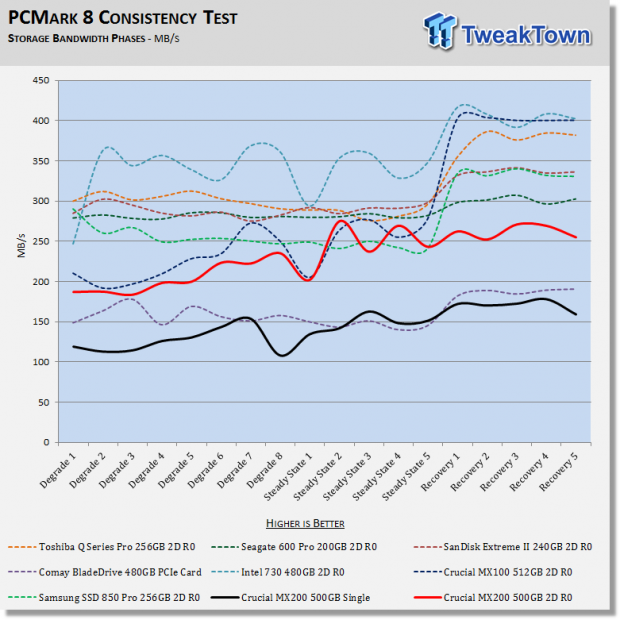
We chart our test subject's storage bandwidth as reported at each of the test's 18 trace iterations. This gives us a good visual perspective of how our test subjects perform as testing progresses.
Total Access Time (Latency)
We chart the total time the disk is accessed as reported at each of the test's 18 trace iterations.
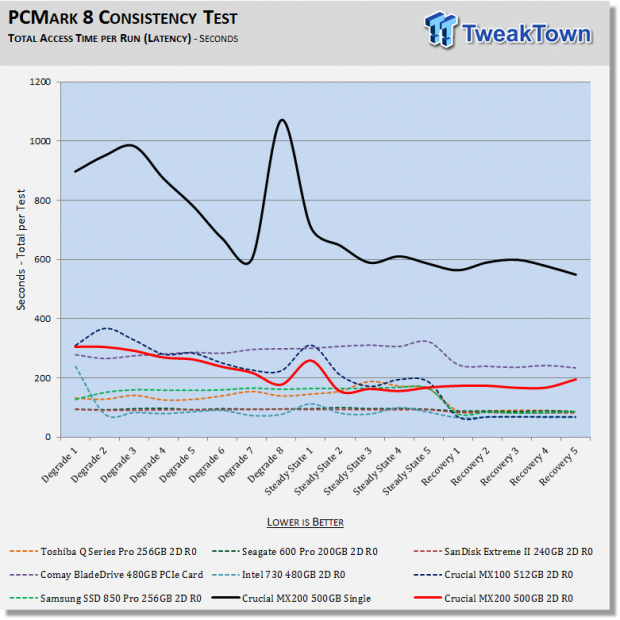
Disk Busy Time
Disk Busy Time is how long the disk is busy working. We chart the total time the disk is working as reported at each of the tests 18 trace iterations.
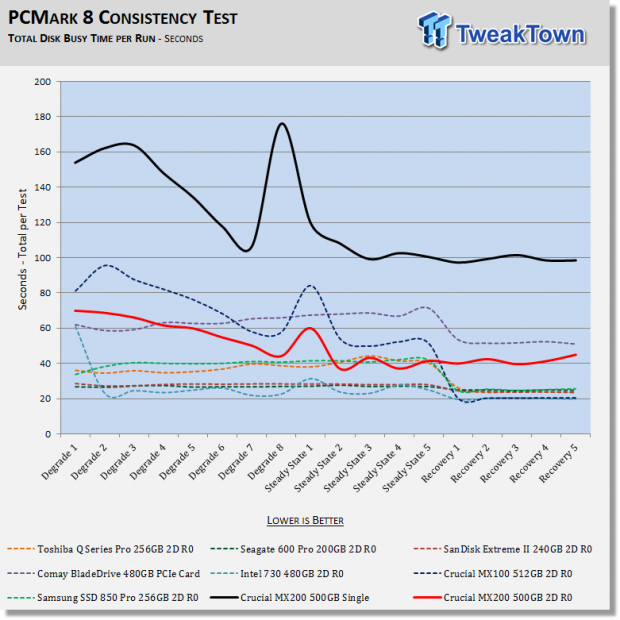
When latency is low, disk busy time is low as well. This mirrors what we saw with our phase portion of this testing. As we have seen throughout our testing, Crucial has improved the latency of the MX200 in comparison to the MX100.
Data Written
We measure the total amount of random data that the drive/arrays are capable of writing during the degradation phases of the consistency test. The total combined time that degradation data is written to the drive/array is 470 minutes. This can be very telling. The better the drive/array can process a continuous stream of random data, the more data will be written.
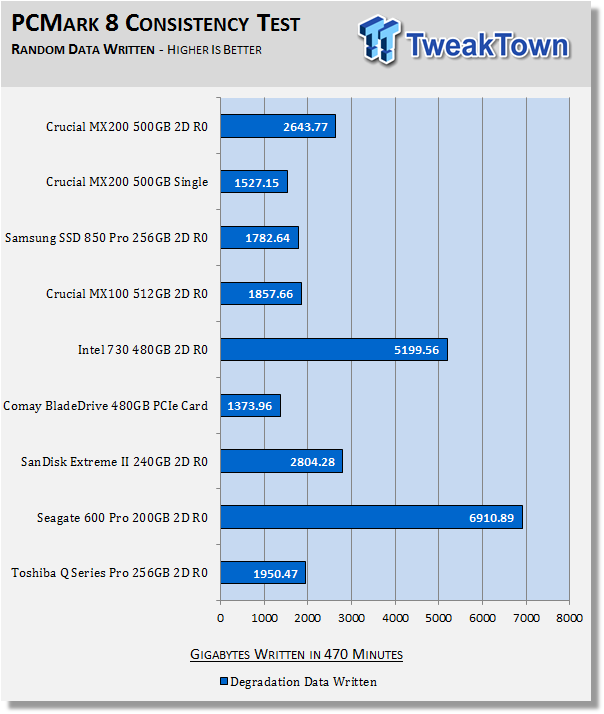
Improved latency in a steady state naturally means that our MX200 array can write more data in the same amount of time than our MX100 array. Our MX200 array performs very well in this test, with only our SanDisk Extreme II array aside from the enterprise class drives able to outperform it.
Final Thoughts
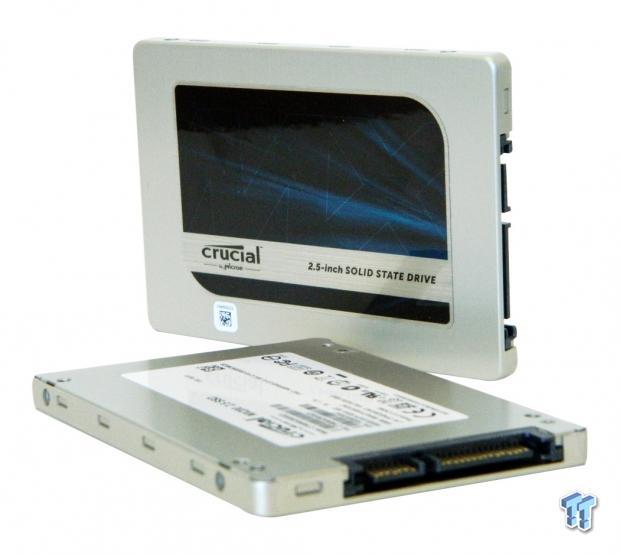
Solid-state storage is the most important performance component found in a modern system today. Without it, you do not even have a performance system.
If you want to have the fastest storage solution in an operating system environment, you need to be running a properly configured RAID 0 SATA based array.
In our opinion, Crucial has a winner in the MX200. Overall Crucial has managed to increase performance over that of the drive it is slated to replace (the MX100), while maintaining the extreme value that the MX100 is renowned for. Let's talk for a moment about what we liked and disliked about the MX200.
What we disliked: This is going to be a short list. Like the MX100, the MX200 falls short when reading random data at high queue depths. In reality, this is not much of an issue because it is only going to matter in a corner case scenario that consumers and enthusiasts will likely never encounter. We also were a little disappointed with the drives performance in our heavy model workload testing and we would like to see a 5 year warranty instead of a 3 year warranty, especially when you consider the massive TBW rating the MX200 has.
What we liked: There is a whole lot to like about the MX200. We loved the MX200's class leading 4K QD1 random write performance. Throughout our testing, the MX200 set lab records in this all-important performance metric. Even more than that, we were blown away by the MX200's superior transfer rate performance, where it left the competition in the dust. We like that the MX200, like its predecessor is constructed from premium components, and that Crucial outfitted the MX200 what we feel is one of the very best flash processors on the market. Crucial's MX series is the only drive in its class to have host power-loss protection. In addition, while we see drives in its price range trending towards inferior TLC NAND, the MX200 has premium MLC flash which makes it inherently superior to drives with TLC flash. We also liked the increased endurance rating.
I highly recommend Crucial's latest SSD. It is in my opinion the best bang for the buck on the market. Although the MX200 is offered as a mid-range piece of hardware in terms of performance, make no mistake, Crucial's MX200 is one of the fastest drives ever made. The MX200's price and performance make it a must have.
RAIDing two or more drives together provides you with storage that takes performance to the next level and is something I recommend you try. Think of it as the SLI of storage. Once you go RAID, there's no going back!
PRICING: You can find Crucial's MX200 (500GB) for sale below. The prices listed are valid at the time of writing but can change at any time. Click the link to see the very latest pricing for the best deal.
United States: The Crucials MX200 500GB retails for $209.99 USD at Amazon USA.
Canada: The Crucials MX200 500GB retails for $274.99 CDN at Amazon Canada.

